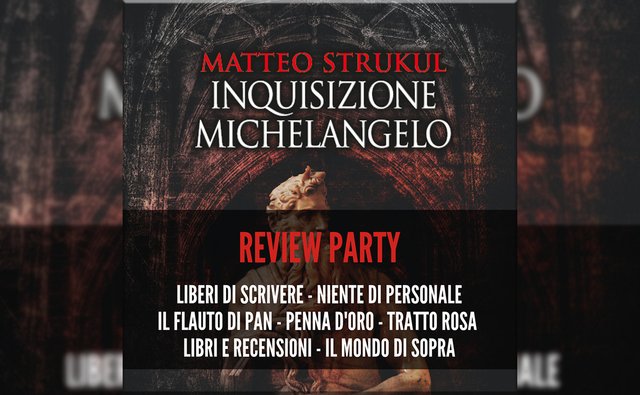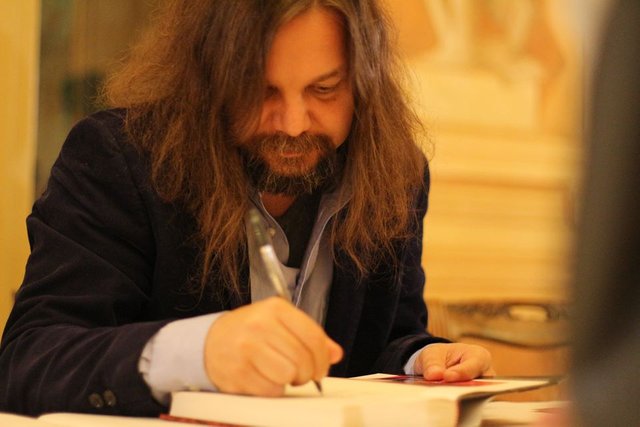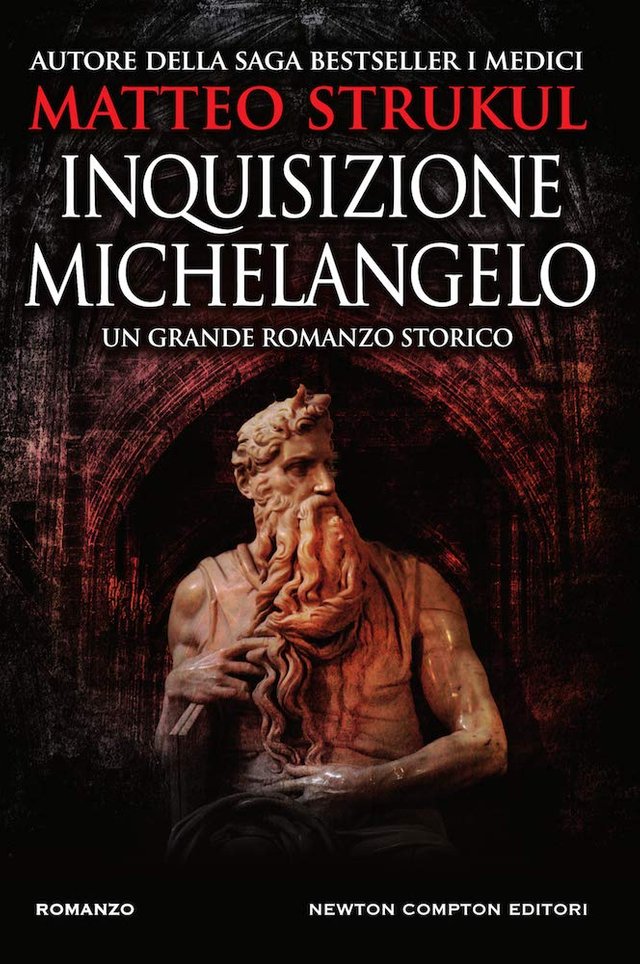The Diary Game 10/09/2021 - Love, art and faith: Michelangelo the Heretic by Matteo Strukul.

In 1543, the year in which the action of the historical novel ‘Michelangelo the Heretic’ by the Italian writer Matteo Strukul begins, Michelangelo Buonarroti was 68 years old. He was recognized as a genius artist, the creator of the frescoes on the ceiling of the Sistine Chapel, an unparalleled sculptor, architect, poet. But the glory had not turned into a fortune, the artist supporting a large family from his work, not always properly rewarded. Those who met him and did not recognize him would have found it hard to believe that they were dealing with one of the greatest artists in human history:
He did not care to be refined in dress and demeanor, on the contrary, a total disinterest in the external order was his way of declaring, no matter where he had gone, how little worldly matters mattered to him. For him there was only art, God and the few friends he had left.
The years 1543-1547 represent a period of deep crisis for Rome in which Michelangelo lives and for the Catholic church in the service of which he had put his talent. The eternal fortress, out of the decline of the Middle Ages, is a conglomeration of contrasts, in which along with the monuments of ruined antiquity are built the magnificent churches of the Renaissance, a city that attracts genius artists but also criminals and prostitutes, in which centuries of moral corruption and material greed erodes the prestige of the church, in which talent, passions, vices, and violence combine into a picturesque and noxious mixture. The spiritual challenge perceived as an existential danger by church leaders comes from the Reformation movement that began a quarter of a century earlier by Martin Luther:
A new wind was blowing from northern Europe. The words of a German monk had ignited the atmosphere with unexpected outbreaks of fire. His theses had been stigmatized on the ecclesiastical body, nails that tore the flesh of the luxury and pomp of a clergyman who had long worshiped material power, sex depravity, and the trafficking of indulgences. The cult of self-love, which had lost the original meaning of the words faith, mercy, mercy, sacrifice.
Michelangelo the Heretic can be seen as the novel of a crisis, a moral crisis through which the artist passes to the age of late maturity. The surrounding realities and political events that call into question the authority of the institution in whose service he had put his formidable talent make him doubt the path followed until then, to fear that it has become a tool of a corrupt system. But maybe it's not a personal crisis, maybe heresy is not his, but the world around him who had lost the compass of values.
How much historical truth should there be and how much should be left to the imagination in such a novel? Is there a proportion of gold? Probably not, and we probably don't even have to look for exact answers to these questions, which have been asked since the first works of the genre, in the older history of literature. After all, there are historical epochs and personalities that we know from literary works rather than from history lessons or treatises, and the novels of Alexandre Dumas, one of Matteo Strukul's declared models, are one of the most famous examples.

Born in 1973 in Padua, the Italian writer who is also a doctor of legal sciences, gained notoriety through a series of novels, the best known being those in the cycle dedicated to the House of Medici, followed by a trilogy of comic books who has Vlad Tepes as his main hero. A picturesque and friendly character, he spends part of his time in Transylvania, currently working on a computer game script and teaching the art of storytelling in Rome.
From the afterword of Michelangelo the Heretic we understand that this novel put him in front of a double challenge. The life of the great artist is quite well documented, both in biographical studies and monographs on art history, and in fiction, where Agony and ecstasy is a very well-known landmark, literary and cinematic.
Approaching the late decades of Michelangelo's life required his efforts not only to create a historically credible character and action, but also by artistically confronting the late stages of the artist's work, who lived to be 90 and created until near the end of his passage through the world. Strukul's success consisted in the fact that his Michelangelo is more than a brilliant artist, he is a complex man, with his crises and doubts, with human passions and weaknesses amplified by his creative force.
Around Michelangelo the author builds a complex world of characters, some inspired by real historical personalities, others imaginary, and a complicated but interesting plot, narrated in successive chapters of a few pages each, most finished in suspense, so that readers it's hard to leave the book in his hand.

The artist lives a late love story (and contrary to his sexual tendencies) with Vittoria Colonna, Marquis of Pescara, real character, poet known at the time. This draws him to the group called Spirituali, formed in the moderate circles of Catholicism led by English Cardinal Reginald Pole. They had adopted a conciliatory line with the Reformation for the Council of Trent, but it would fail in its attempt to avoid schism in the Western church.
This group is opposed by Cardinal Gian Petro Carafa, the new leader of the newly established Holy Office of the Inquisition, who pursues Spirituali through Vittorio Corsini, the captain of the Inquisition guards, the courtesan Imperia, and the young Disgrace, a street child raised to become thief and spy, and doomed to a tragic fate worthy of her unfortunate name. The old Pope Paul III, patron of the arts, protects Michelangelo to a certain extent, but his age and the difficult confrontation with the complex situation of the papal institution do not allow him to avoid the conflict between the two camps.
Much of the action is an extrapolation of indirect information and is also based on interpretations of how Michelangelo's creation evolved during that period. There was no written information that the ideas of the Reformation would have attracted or influenced the artist. These aspects of the novel's hero personality are only possible and credible, as is his attachment to faith and the power of art.
Matteo Strukul eloquently reconstructs for his readers 16th century Rome, with its people and streets, with the scents and miasmas of the air, with palaces and dungeons, with the burning of the Inquisition and with the bloodthirsty crowd. Churches grow in the vicinity of the ruins of ancient temples, and St. Peter's Basilica itself is a site of what would become the glory of Catholicism, with the ruins of the old basilica and the temple of Constantine still visible. Michelangelo faces his own creation. His nights are still haunted by the nightmares of the years spent on the scaffolding above which the vault of the Sistine Chapel was born, and his Last Judgment and Piety are painted as no one else had dared to do before.

‘Michelangelo the Heretic’ is a book that will make lovers of historical novels, art lovers and those fascinated by the Renaissance period with its great artists happy. 16th century Rome, the landscapes and people of the Italian peninsula and of Europe from that crossroads of history, times full of violence, but also generators of beauty, come to life in the pages of the book. It is not easy to create a character according to the existing representations, the literary ones but also the ones formed in the minds of each of us, of Michelangelo Buonarroti, but Matteo Strukul managed to do it. His Michelangelo is a man who believes in God and art, a man who values life, love and friendship, and who is ready to sacrifice himself completely to fulfill his ideals. The plot of the book and the course of his life confront him with defeats, he fails to protect his loves and friends, and his ideals are eroded by the waves of history. However, his victory and fulfillment will materialize wonderfully in his artistic creation.
Image Sources:
Inquisizione Michelangelo Copertina